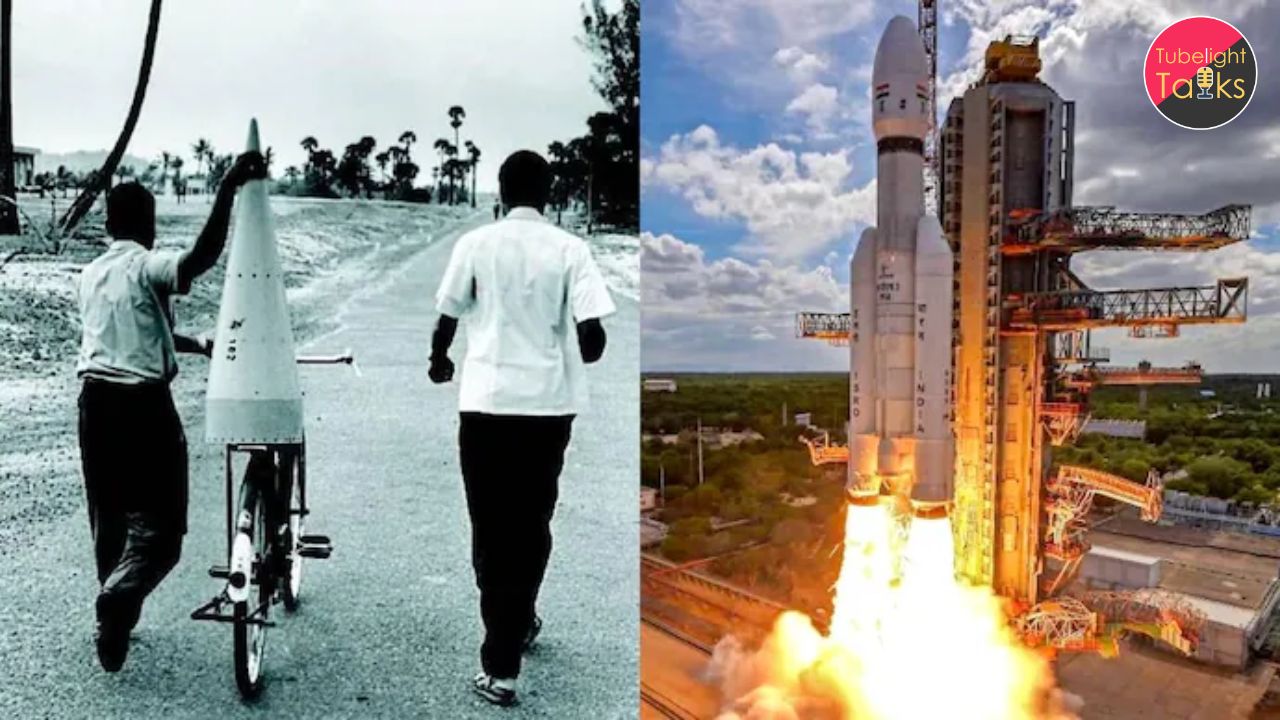The Indian Space Research Organisation (ISRO), established in 1969, has become a key player in the global space exploration arena. Its remarkable journey from humble beginnings to becoming one of the world’s most renowned space agencies highlights its ingenuity, dedication, and commitment to innovation. From transporting rocket parts by bicycles to developing state-of-the-art mission launch vehicles, ISRO’s evolution is an inspiring story of progress and achievement in space technology.
Early Days of Indian Space Research Organisation (ISRO): A Humble Beginning
Indian Space Research Organisation (ISRO): In the early 1960s, when ISRO was still in its formative stages, India had limited resources to pursue space exploration. The Indian National Committee for Space Research (INCOSPAR), established in 1962 under the guidance of Dr. Vikram Sarabhai, was the foundation of ISRO. The organization’s journey began with humble efforts, such as transporting rockets and satellite components using bicycles and bullock carts.
This resourcefulness and commitment to the cause were crucial in overcoming the early challenges. Despite these limitations, the team at ISRO worked tirelessly to lay the groundwork for future space exploration.
Milestones in Space Exploration of Indian Space Research Organisation (ISRO)
Aryabhata: India’s First Satellite (1975)
The year 1975 marked a major milestone for ISRO with the successful launch of Aryabhata, India’s first satellite. This accomplishment positioned India among the world’s leading space nations and established a groundwork for the country’s future pursuits in space exploration.
Chandrayaan Missions: Exploring the Moon
The launch of Chandrayaan-1 in 2008 significantly enhanced ISRO’s space exploration capabilities, representing India’s inaugural mission to the Moon.This mission made significant discoveries, including the presence of water molecules on the Moon’s surface. The success of Chandrayaan-2 in 2019, followed by the historic landing of Chandrayaan-3 on the Moon’s South Pole in 2023, solidified India’s leadership in lunar exploration.
Also Read: ISRO’s EOS-08 Satellite Launch Advancing Earth Observation
Mars Orbiter Mission (Mangalyaan): Reaching Mars
In 2013, ISRO made history by launching Mangalyaan (Mars Orbiter Mission), making India the first Asian nation to reach Mars orbit. The success of this mission demonstrated ISRO’s ability to conduct interplanetary missions with remarkable cost-effectiveness. It garnered international praise for its efficient use of resources and the timely achievement of its goals.
Recent Achievements by ISRO: A New Era of Space Exploration
Aditya-L1: A Solar Exploration Mission
In September 2023, ISRO launched the Aditya-L1 mission, a solar observatory designed to study the Sun’s corona and solar activities. This mission aims to increase our understanding of the Sun’s impact on space weather, providing valuable data to improve life on Earth.
Gaganyaan: India’s First Human Spaceflight
One of the most ambitious projects on the horizon for ISRO is the Gaganyaan mission, which marks India’s inaugural human spaceflight initiative. Set to launch in the near future, Gaganyaan will mark a significant achievement for India, bringing the country into the elite group of nations capable of sending humans into space.
Shukrayaan and Mangalyaan-2: Exploring Venus and Mars
ISRO’s interplanetary ambitions continue with the development of the Shukrayaan mission, which aims to explore Venus, and Mangalyaan-2, which will further our understanding of Mars. These missions promise to deepen our knowledge of the solar system and reaffirm ISRO’s position as a leader in space research.
The Role of ISRO’s Launch Vehicles
Indian Space Research Organisation (ISRO): ISRO has developed several robust launch vehicles over the years, including the Polar Satellite Launch Vehicle (PSLV) and the Geosynchronous Satellite Launch Vehicle (GSLV). These vehicles have enabled the successful launch of numerous satellites and interplanetary missions, showcasing India’s growing space capabilities.
Also Read: From Bicycles to Rockets: ISRO’s 46-Year Journey to 100 Missions
ISRO’s recent advancements in launch vehicle technology reflect the organization’s continuous pursuit of excellence. With each mission, the agency has gained valuable experience, improving its ability to conduct complex launches with precision and efficiency.
Conclusion: A Future of Infinite Possibilities
Indian Space Research Organisation (ISRO): The journey of ISRO, from humble beginnings to its current status as a leading global space agency, serves as a testament to India’s commitment to space exploration and technological innovation. While the organization has made tremendous strides, its ambitious goals—such as the Gaganyaan mission, Venus exploration with Shukrayaan, and Mars missions—highlight that ISRO’s story is far from over.
With each mission, ISRO not only contributes to the scientific community but also inspires future generations to dream big and reach for the stars. As the agency continues to break new barriers in space exploration, its legacy will undoubtedly leave a lasting impact on humanity’s quest to explore the cosmos.
ISRO’s remarkable achievements in space exploration—like Chandrayaan-3 and Mangalyaan—highlight India’s commitment to discovering the secrets of the universe. Similarly, Sant Rampal Ji Maharaj emphasizes discovering the deeper truths of life and the universe through true spiritual knowledge.
As ISRO investigates the outer cosmos, Sant Rampal Ji directs us to delve into the inner realm—the soul. His teachings, based on holy scriptures like the Vedas, Gita, and Bible, reveal the true way to attain salvation and eternal peace. He clarifies that adhering to the guidance provided by the Supreme God Kabir Saheb enables an individual to escape the cycle of birth and death. Sant Rampal Ji’s message promotes equality, non-violence, devotion, and righteous living.
To learn more about these spiritual truths and gain clarity about life’s real purpose, watch Sant Rampal Ji Maharaj’s enlightening discourses on Sant Rampal Ji Maharaj YouTube Channel. It’s a journey worth beginning today.
FAQ’S
1. What is ISRO and when was it established?
Answer: ISRO is the space agency of the Government of India, responsible for space research and satellite development. It was established on August 15, 1969, under the visionary guidance of Dr. Vikram Sarabhai.
2. What was the first satellite launched by ISRO?
Answer: ISRO’s first satellite was Aryabhata, launched on April 19, 1975, from the Soviet Union. It marked India’s entry into space exploration.
3. What are ISRO’s most notable missions?
Answer: Some of ISRO’s landmark missions include Chandrayaan-1 & 2, Chandrayaan-3, Mangalyaan (Mars Orbiter Mission), Aditya-L1, and the upcoming Gaganyaan human spaceflight mission.
4. What is the full form of PSLV and GSLV?
Answer:
- PSLV: Polar Satellite Launch Vehicle
- GSLV: Geosynchronous Satellite Launch Vehicle
These are India’s primary space launch vehicles.
5. How is ISRO different from NASA?
Answer: ISRO focuses on cost-effective space technology and satellite services, while NASA has a larger budget and broader scope, including deep space missions. Both agencies contribute significantly to global space research.







![James Webb Space Telescope First Photo [Hindi] ब्रह्मांड के खुलेंगे रहस्य](https://tubelighttalks.com/wp-content/uploads/2022/07/James-Webb-Space-Telescope-First-Photo-Hindi-ब्रह्मांड-के-खुलेंगे-रहस्य-1.jpg)


